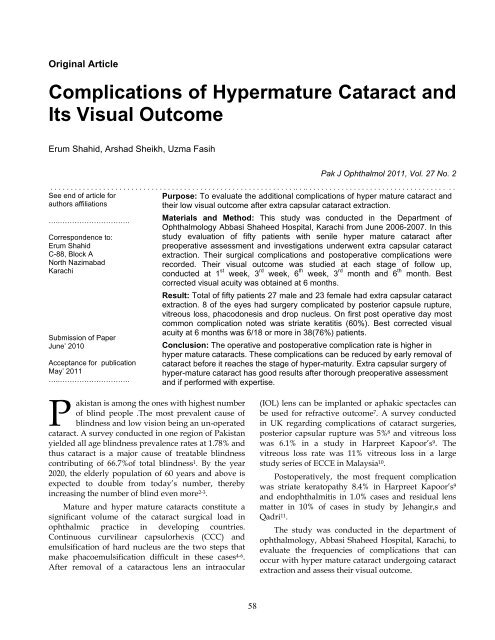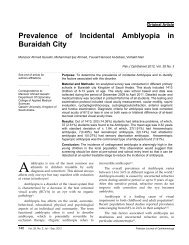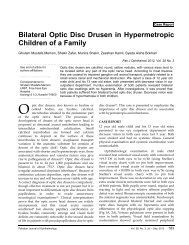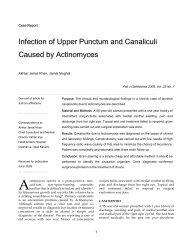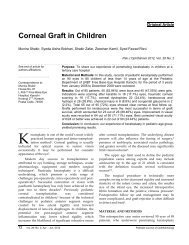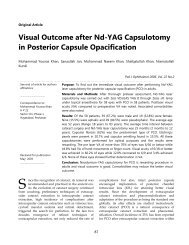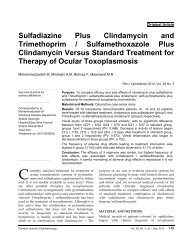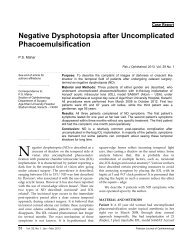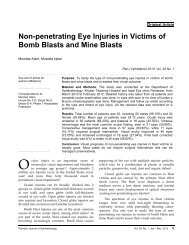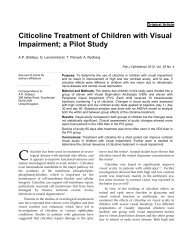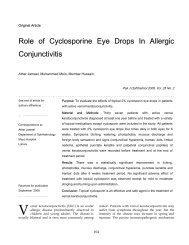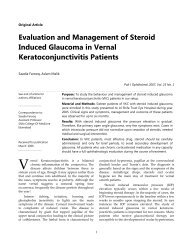Complications of Hypermature Cataract and Its Visual Outcome
Complications of Hypermature Cataract and Its Visual Outcome
Complications of Hypermature Cataract and Its Visual Outcome
You also want an ePaper? Increase the reach of your titles
YUMPU automatically turns print PDFs into web optimized ePapers that Google loves.
Original Article<br />
<strong>Complications</strong> <strong>of</strong> <strong>Hypermature</strong> <strong>Cataract</strong> <strong>and</strong><br />
<strong>Its</strong> <strong>Visual</strong> <strong>Outcome</strong><br />
Erum Shahid, Arshad Sheikh, Uzma Fasih<br />
Pak J Ophthalmol 2011, Vol. 27 No. 2<br />
. . . . . . . . . . . . . . . . . . . . . . . . . . . . . . . . . . . . . . . . . . . . . . . . . . . . . . . . . . . . .. . .. . . . . . . . . . . . . . . . . . . . . . . . . . . . . . . . . . . . .<br />
See end <strong>of</strong> article for<br />
Purpose: To evaluate the additional complications <strong>of</strong> hyper mature cataract <strong>and</strong><br />
authors affiliations<br />
their low visual outcome after extra capsular cataract extraction.<br />
…..………………………..<br />
Correspondence to:<br />
Erum Shahid<br />
C-88, Block A<br />
North Nazimabad<br />
Karachi<br />
Submission <strong>of</strong> Paper<br />
June’ 2010<br />
Acceptance for publication<br />
May’ 2011<br />
…..………………………..<br />
Materials <strong>and</strong> Method: This study was conducted in the Department <strong>of</strong><br />
Ophthalmology Abbasi Shaheed Hospital, Karachi from June 2006-2007. In this<br />
study evaluation <strong>of</strong> fifty patients with senile hyper mature cataract after<br />
preoperative assessment <strong>and</strong> investigations underwent extra capsular cataract<br />
extraction. Their surgical complications <strong>and</strong> postoperative complications were<br />
recorded. Their visual outcome was studied at each stage <strong>of</strong> follow up,<br />
conducted at 1 st week, 3 rd week, 6 th week, 3 rd month <strong>and</strong> 6 th month. Best<br />
corrected visual acuity was obtained at 6 months.<br />
Result: Total <strong>of</strong> fifty patients 27 male <strong>and</strong> 23 female had extra capsular cataract<br />
extraction. 8 <strong>of</strong> the eyes had surgery complicated by posterior capsule rupture,<br />
vitreous loss, phacodonesis <strong>and</strong> drop nucleus. On first post operative day most<br />
common complication noted was striate keratitis (60%). Best corrected visual<br />
acuity at 6 months was 6/18 or more in 38(76%) patients.<br />
Conclusion: The operative <strong>and</strong> postoperative complication rate is higher in<br />
hyper mature cataracts. These complications can be reduced by early removal <strong>of</strong><br />
cataract before it reaches the stage <strong>of</strong> hyper-maturity. Extra capsular surgery <strong>of</strong><br />
hyper-mature cataract has good results after thorough preoperative assessment<br />
<strong>and</strong> if performed with expertise.<br />
P<br />
akistan is among the ones with highest number<br />
<strong>of</strong> blind people .The most prevalent cause <strong>of</strong><br />
blindness <strong>and</strong> low vision being an un-operated<br />
cataract. A survey conducted in one region <strong>of</strong> Pakistan<br />
yielded all age blindness prevalence rates at 1.78% <strong>and</strong><br />
thus cataract is a major cause <strong>of</strong> treatable blindness<br />
contributing <strong>of</strong> 66.7%<strong>of</strong> total blindness 1 . By the year<br />
2020, the elderly population <strong>of</strong> 60 years <strong>and</strong> above is<br />
expected to double from today’s number, thereby<br />
increasing the number <strong>of</strong> blind even more 2-3 .<br />
Mature <strong>and</strong> hyper mature cataracts constitute a<br />
significant volume <strong>of</strong> the cataract surgical load in<br />
ophthalmic practice in developing countries.<br />
Continuous curvilinear capsulorhexis (CCC) <strong>and</strong><br />
emulsification <strong>of</strong> hard nucleus are the two steps that<br />
make phacoemulsification difficult in these cases 4-6 .<br />
After removal <strong>of</strong> a cataractous lens an intraocular<br />
(IOL) lens can be implanted or aphakic spectacles can<br />
be used for refractive outcome 7 . A survey conducted<br />
in UK regarding complications <strong>of</strong> cataract surgeries,<br />
posterior capsular rupture was 5% 8 <strong>and</strong> vitreous loss<br />
was 6.1% in a study in Harpreet Kapoor’s 9 . The<br />
vitreous loss rate was 11% vitreous loss in a large<br />
study series <strong>of</strong> ECCE in Malaysia 10 .<br />
Postoperatively, the most frequent complication<br />
was striate keratopathy 8.4% in Harpreet Kapoor’s 9<br />
<strong>and</strong> endophthalmitis in 1.0% cases <strong>and</strong> residual lens<br />
matter in 10% <strong>of</strong> cases in study by Jehangir,s <strong>and</strong><br />
Qadri 11 .<br />
The study was conducted in the department <strong>of</strong><br />
ophthalmology, Abbasi Shaheed Hospital, Karachi, to<br />
evaluate the frequencies <strong>of</strong> complications that can<br />
occur with hyper mature cataract undergoing cataract<br />
extraction <strong>and</strong> assess their visual outcome.<br />
58
MATERIALS AND METHODS<br />
A descriptive study was conducted in the department<br />
<strong>of</strong> ophthalmology at Abbasi Shaheed Hospital <strong>and</strong> it<br />
was completed in almost a year. 50 patients were<br />
selected from an eye OPD with senile hyper mature<br />
cataracts. Their complete history was taken, thorough<br />
ocular examinations including B scan <strong>and</strong> systemic<br />
investigations where required.<br />
All the surgeries were planned day care extra<br />
capsular cataract extraction <strong>and</strong> were performed<br />
under local anaesthesia by a single experienced<br />
surgeon. Dispersive ophthalmic viscoadaptives were<br />
used during surgery. <strong>Complications</strong> encountered<br />
during <strong>and</strong> after surgeries were noted down. Sutures<br />
were removed after three months. Patients were<br />
followed regularly up to six months.<br />
Data was entered <strong>and</strong> analyzed by SPSS computer<br />
s<strong>of</strong>tware version 11.5.<br />
Frequencies <strong>and</strong> percentages were computed for<br />
age, gender, preoperative, intra operative,<br />
postoperative complications <strong>and</strong> visual acuity.<br />
RESULTS<br />
The study was conducted on total <strong>of</strong> 50 patients with<br />
hyper mature cataract <strong>and</strong> they were evaluated<br />
according to the designed performa. They consisted <strong>of</strong><br />
27 (54%) males <strong>and</strong> 23 (46%) females. 28 (56%) <strong>of</strong> them<br />
had right eye <strong>and</strong> 22 (44%) had left eye operated<br />
(Table 1).<br />
The age range was 50 to 80 years with a mean age<br />
63.78 years. s9 (18%) <strong>of</strong> these patients had other<br />
systemic illness like diabetes <strong>and</strong> hypertension.<br />
Pre-operative VA was recorded which ranged<br />
from light perception (LP) to counting finger (CF)<br />
(Table 2). Majority <strong>of</strong> them had CF <strong>and</strong> HM i.e. 16<br />
(32%) each. 3 (6%) <strong>of</strong> the patients presented with<br />
subluxated lenses preoperatively <strong>and</strong> 6 (12%) had<br />
posterior synechiae resulting in poor pupillary<br />
dilatation (Table 3).<br />
Forty two (84%) <strong>of</strong> these patients had uneventful<br />
surgery while 8 (16%) <strong>of</strong> them developed some<br />
complications intraoperatively. Nine (18%) had poor<br />
pupillary dilation, 6 (12%) had posterior capsular<br />
rupture <strong>and</strong> vitreous loss, 2 (4%) had phacodonesis<br />
due to weak zonules <strong>and</strong> 1 (2%) developed dropped<br />
nucleus in vitreous (Table 4).<br />
Most <strong>of</strong> the patients 42 (84%) had posterior<br />
chamber intra ocular lenses implanted. 4 (8%) <strong>of</strong> them<br />
were managed with anterior chamber intra ocular<br />
lenses <strong>and</strong> 4 (8%) were left aphakic.<br />
Table 1: Gender Distribution<br />
Sex No. <strong>of</strong> Patients n (%)<br />
Male 27 (54)<br />
Female 23 (46)<br />
Total 50 (100)<br />
Table 2: <strong>Visual</strong> acuity before surgical procedure<br />
VA No. <strong>of</strong> Patients n (%)<br />
CF 16 (32)<br />
HM 16 (32)<br />
PLPR 14 (28)<br />
PL 04 (8)<br />
Total 50 (100)<br />
Table 3: Pre operative complications<br />
<strong>Complications</strong> No. <strong>of</strong> Patients n (%)<br />
Posterior synechiae 6 (12)<br />
Subluxated lens 3 (6)<br />
Total 9 (18)<br />
Table 4: <strong>Complications</strong> encountered during surgery<br />
<strong>Complications</strong> No. <strong>of</strong> Patients n (%)<br />
Poor pupillary dilatation 9 (18)<br />
Pc rupture 6 (12)<br />
Vitreous loss 6 (12)<br />
Phacodonesis 2 (4)<br />
Drop nucleus 1 (2)<br />
On the first post operative day their visual acuity<br />
ranged from h<strong>and</strong> movement to 6/12, 25 (50%) had<br />
visual acuity 6/60 <strong>and</strong> 6/36 (Table 6).this was<br />
59
improved with pinhole. Post operative follow up was<br />
done at 1st week, 3 rd week, 6 th week, 3 rd month <strong>and</strong> 6 th<br />
month. <strong>Visual</strong> acuity had improved by the last followup<br />
<strong>and</strong> only 12 (24%) had vision between 6/60 <strong>and</strong><br />
6/24 (Table 6).<br />
Early post operative complications were seen in 31<br />
(62%) eyes (Table 5), the most common being striate<br />
keratopathy 30 (60%), iritis 5 (10%), irregular pupil 3<br />
(6%), sub conjunctival hemorrhage 2 (4%), cystoid<br />
macular edema 2 (4%), hyphaema, lens matter in AC<br />
<strong>and</strong> primary capsular thickening in 1 (2%)<br />
respectively. The results are illustrated in the given<br />
tables.<br />
Table 5: Early post operative complications<br />
<strong>Complications</strong> No. <strong>of</strong> Patients n (%)<br />
Striate keratopathy 30 (60)<br />
Iritis 4 (8)<br />
Irregular pupil 3 (6)<br />
Sub conjunctival<br />
hemorrhage<br />
2(4)<br />
CME 2 (4)<br />
Lens matter 1 (2)<br />
Hyphaema 1 (2)<br />
PCO 1 (2)<br />
Table 6: VA on 1st post operative day <strong>and</strong> 6 months<br />
VA<br />
1 st postoperative day<br />
n (%)<br />
HM-CF 13(26) 0<br />
Six months<br />
n (%)<br />
6/60-6/24 29(58) 12(24)<br />
6/18-6/12 08(16) 16(32)<br />
6/9-6/6 0(0) 22(44)<br />
Total 50(100) 50(100)<br />
DISCUSSION<br />
Mature <strong>and</strong> hyper mature cataracts constitute a<br />
significant volume <strong>of</strong> the cataract surgical load in<br />
ophthalmic practice in the developing world5,6 <strong>and</strong> 12.<br />
The prevalence <strong>of</strong> visual impairment <strong>and</strong><br />
blindness is 1,140,000 (962,000–1,330,000) in Pakistan<br />
(2003 statistics). Blindness prevalence varies<br />
throughout the country. Rural areas had a higher<br />
prevalence <strong>of</strong> blindness than did urban areas (3.8% vs.<br />
2.5%) 13 .<br />
In our neighboring country, there are 12.5 million<br />
blind <strong>and</strong> it is estimated that 50% to 80% 14,15 are blind<br />
due to cataract. Most patients have advanced stages <strong>of</strong><br />
cataract with intumescent, mature or hyper mature<br />
cataracts. Majority <strong>of</strong> these patients are socioeconomically<br />
disadvantaged <strong>and</strong> cannot afford procedures<br />
such as phaco-emulsification. Conventionally an Extra<br />
Capsular <strong>Cataract</strong> Extraction with Posterior Chamber<br />
Intraocular Lens Implantation (ECCE-PC IOL) is<br />
considered to be an effective means <strong>of</strong> restoring visual<br />
function in developing countries. However, it has its<br />
own problems related to wound suturing <strong>and</strong> its<br />
associated complications <strong>and</strong> late visual<br />
rehabilitation 16 .<br />
One <strong>of</strong> the commonest complications encountered<br />
during an ECCE <strong>of</strong> hyper-mature cataract in this study<br />
was posterior capsule rupture with vitreous loss<br />
(12%), which is also the commonest in other studies 17,<br />
18 . Their frequencies are far less as compared to ours<br />
i.e. 5.7% <strong>and</strong> 0%. All <strong>of</strong> the cataracts with which we<br />
are dealing are hyper mature, these are associated<br />
with capsular fibrosis <strong>and</strong> loss <strong>of</strong> elasticity. One <strong>of</strong> the<br />
study conducted in a local hospital at Rawalpindi 19<br />
had similar complications like pupillary miosis,<br />
posterior capsular rupture, <strong>and</strong> vitreous loss (6.6%)<br />
<strong>and</strong> lens subluxation. 2% had dropped nucleus, which<br />
is not common in case <strong>of</strong> extra capsular cataract<br />
extraction.<br />
The frequency <strong>of</strong> capsular rupture <strong>and</strong> vitreous<br />
loss can be reduced by staining the anterior capsule<br />
with trypan blue, to identify the capsular tear at an<br />
early stage 17 . The most common early post-operative<br />
complication was striate keratitis (60%). This<br />
complication was higher than other studies 20 since all<br />
the cataracts are hyper mature <strong>and</strong> had large incision<br />
cataract extraction. They are associated with high rate<br />
<strong>of</strong> vitreous loss requiring vitrectomy <strong>and</strong> prolonged<br />
surgical time <strong>and</strong> more endothelial cell loss. Ideally<br />
specular microscopy should be used preoperatively<br />
<strong>and</strong> post operatively 21 . These complications can be<br />
reduced by irrigation <strong>and</strong> aspiration in a closed<br />
chamber after insertion <strong>of</strong> an intra ocular lens <strong>and</strong><br />
suturing.<br />
60
Hemorrhagic complications (4.02) <strong>and</strong><br />
inflammatory complications (8.72) are comparable to a<br />
study conducted in Russia 22 .<br />
Pupil distortion (6%) is comparable to one in<br />
Nigeria (5.6%) 23 but the rate <strong>of</strong> posterior capsular<br />
opacity is (2%) as compared to (7%). As ECCE with an<br />
IOL is associated with long-term complications <strong>and</strong><br />
our follow up was up to 6 months. The long-term<br />
effect <strong>of</strong> posterior capsular opacification (PCO) needs<br />
to be assessed in larger populations 24 . Our sample size<br />
was only 50.<br />
Preoperatively, the study population presented<br />
with poor vision i.e. less than 6/60 in all <strong>of</strong> the cases.<br />
The first post operative day visual acuity was poor (i.e.<br />
6/60 or less) in 26%, border line (6/36 to6/24) in 58%<br />
<strong>and</strong> good visual acuity (i.e. 6/18 or above according to<br />
WHO) in 16% <strong>of</strong> cases. At 3 months <strong>and</strong> 6 months 76%<br />
had good best corrected VA i.e. 6/18 or better. It is<br />
comparable to the study related to visual outcome<br />
after vitreous loss 25 in which 91% <strong>of</strong> eyes had vitreous<br />
loss <strong>and</strong> they had best corrected visual acuity <strong>of</strong> 6/9 or<br />
better. Similarly the results <strong>of</strong> another study 26 also<br />
showed that most <strong>of</strong> the patients after vitreous loss do<br />
reasonably well however their final visual out come<br />
was affected by cystoid macular edema, which was 4%<br />
in this study. Two <strong>of</strong> our study population (4%) had<br />
VA less than 6/36 due to age related macular<br />
degeneration. In cases <strong>of</strong> coexistent ocular diseases,<br />
macular degeneration was the main cause <strong>of</strong> reduced<br />
vision, accounting for 50% <strong>of</strong> those eyes with less than<br />
6/18 <strong>and</strong> 46% <strong>of</strong> those with less than 6/60 best<br />
corrected visual acuity 27 . 57% <strong>and</strong> 77% cases had<br />
uncorrected VA at 3 months more than 6/18 in<br />
Watson <strong>and</strong> Minassiana studies 28,16 . The results are<br />
comparable to a local study where final visual acuity<br />
reached 6/12 or better in 77% <strong>of</strong> eyes after ECCE 19 <strong>and</strong><br />
80% achieved a final VA <strong>of</strong> 6/18 or better in review <strong>of</strong><br />
400 cases 29 with similar complications. The good visual<br />
outcome signifies the importance <strong>of</strong> thorough<br />
preoperative assessment including macular function<br />
test, pupillary reflex <strong>and</strong> B-scan in cases where the<br />
fundus was not visible.<br />
The outcomes <strong>of</strong> ECCE are good with fewer<br />
complications if performed with pr<strong>of</strong>essional skills.<br />
ECCE also favors economic factors for the population<br />
<strong>of</strong> this region 19 .<br />
The incidence <strong>of</strong> blindness in Pakistan suggests<br />
that eye care facilities in general are inadequate.<br />
Vision screening programs should be implemented on<br />
larger scales 30 . A large number <strong>of</strong> population in<br />
developing countries are still presenting with hyper<br />
mature cataracts. They should be advised for early<br />
removal <strong>of</strong> cataract before its progression to hyper<br />
maturity. Early removal reduces the rate <strong>of</strong><br />
complications <strong>and</strong> fastens the rate <strong>of</strong> rehabilitation.<br />
White cataracts require more pr<strong>of</strong>essional skills.<br />
CONCLUSION<br />
We conclude from our study that the chances <strong>of</strong><br />
complications are higher in advanced cataracts. These<br />
complications can be reduced by irrigation <strong>and</strong><br />
aspiration in a closed chamber after insertion <strong>of</strong><br />
intraocular lens <strong>and</strong> suturing.<br />
Patients should be advised to seek medical advise<br />
early for defective vision.<br />
Author’s affiliation<br />
Dr. Erum Shahid<br />
C-88, Block A<br />
North Nazimabad<br />
Karachi<br />
Dr. Arshad Sheikh<br />
Pr<strong>of</strong>. <strong>and</strong> Head <strong>of</strong> Department Ophthalmology<br />
Abbasi Shaheed Hospital<br />
Karachi<br />
Dr. Uzma Fasih<br />
Assistant Pr<strong>of</strong>essor Ophthalmology<br />
Abbasi Shaheed Hospital<br />
Karachi<br />
REFERENCE<br />
1. Khan AQ, Qureshi B, Khan D. Rapid assessment <strong>of</strong> cataract<br />
blindness, in age 40 years <strong>and</strong> above in district Skardu,<br />
Baltistan, Northern areas, Pakistan. Pak J Ophthalmol. 2003; 19:<br />
84-9.<br />
2. Minassian DC, Mehra V. 3.8 million blinded by cataract each<br />
year: projection from the first epidemiological study <strong>of</strong><br />
incidence <strong>of</strong> cataract blindness in India. Br J Ophthalmol. 1990;<br />
74: 341-3.<br />
3. Shaikh MR, Janju MZ., Morphological <strong>and</strong> morphometrical<br />
study <strong>of</strong> hu more pr<strong>of</strong>essional expertise man lens in senile<br />
cataract. J Pak Med. 1997; 47: 141-4.<br />
4. Hausmann N, Richard G. investigations on diathermy for<br />
anterior capsulotomy.Invest ophthalmol Vis sci 1991; 32:2155-<br />
59.<br />
5. Chakarabati A, Singh S, Krishna as R. Phacoemulsification in<br />
eyes with white cataract. J <strong>Cataract</strong> Refract Surg. 2000; 26: 1041-<br />
47.<br />
6. Vajpayee RB, Angra SK, Honavar SG, et al. Capsulotomy for<br />
phacoemulsification in hypermature cataracts. J <strong>Cataract</strong><br />
Refract Surg. 1995; 21: 612-5.<br />
7. American Academy <strong>of</strong> ophthalmology. Surgery for cataract.In:<br />
American Academy <strong>of</strong> ophthalmology. Lens <strong>and</strong> cataract, 1999-<br />
61
2000. Sanfrancisco: American Academy <strong>of</strong> ophthalmology.<br />
1999: 77-139.<br />
8. Parcel D., The National <strong>Cataract</strong> Surgery Survey 2Clinical out<br />
come J the eye. 1993; 7: 489-94.<br />
9. Kapoor H, Chattergee A, Daniel Foster A. Evaluation <strong>of</strong> visual<br />
outcome <strong>of</strong> cataract surgery in an Indian eye camp. Br J<br />
Ophthalmol. 1999; 83: 343-6.<br />
10. Lewallan S, Le Mesurier RT. Extracapsular cataract extraction<br />
in developing countries. Arch Ophthalmol. 1993; 111-18.<br />
11. Jehangir S, Kadri WM. Extracapsular cataract extraction with<br />
intraocular lens implantation in Pakistan. Pak J Ophthalmol.<br />
1988; 3: 80-2.<br />
12. Vasavada A, Singh R, Desai J. Phacoemulsification <strong>of</strong> white<br />
mature cataracts. J <strong>Cataract</strong> Refract Surg. 1998; 24: 270-7.<br />
13. Jadoon MZ, Dineeen B, Bourne RA, et al. Prevalence <strong>of</strong><br />
Blindness <strong>and</strong> <strong>Visual</strong> Impairment in Pakistan:The Pakistan<br />
National Blindness <strong>and</strong> <strong>Visual</strong> Impairment Survey. Invest<br />
Ophthalmol. 2006; 11: 4749-55.<br />
14. D<strong>and</strong>ona L, D<strong>and</strong>ona R, Naduvilath T, et al. Is the current<br />
eye-care policy focus almost exclusively on cataract adequate<br />
to deal with blindness in India The Lancet. 1998; 74: 341-3.<br />
15. Jose R. National Programme for control <strong>of</strong> blindness. Indian J<br />
Community Health. 1997; 3: 5-9.<br />
16. Minassiana DC, Rosenc P, Dartb JKB, et al. Extracapsular<br />
cataract extraction compared with small incision surgery by<br />
phacoemulsification: a r<strong>and</strong>omized trial. Br J Ophthalmol.<br />
2001; 85: 822-9.<br />
17. Kothari K, Jain SS, Shah NJ. Anterior capsular staining with<br />
trypan blue for capsulorhexis in mature <strong>and</strong> hypermature<br />
cataracts. A preliminary study. Indian J Ophthalmol. 2001; 49:<br />
177-80.<br />
18. Tilahum Y, Sisay A. Audit <strong>of</strong> extracapsular cataract extraction<br />
with posterior chamber intraocular lens implantation in a<br />
tertiary eye care centre in Ethiopia. Ethiop Med J. 2006; 44: 61-6.<br />
19. Raja N, Niazi MK. Phacoemulsification versus extracapsular<br />
cataract extraction: The visual outcome. Pak J Surg. 2003; 19:<br />
77-81.<br />
20. Dulayajinda D, Nukhaw W, Kampanartsanyakorn S, et al.<br />
<strong>Outcome</strong>s <strong>of</strong> cataract surgery in senile cataract patients at<br />
Siriraj hospital: a prospective observational study. J Med Assoc<br />
Thai. 2005; 9: 82-8.<br />
21. Leatherbarrow B, Trevett A, Tullo AB. Secondary lens<br />
implantation: incidence, indications <strong>and</strong> complications. Eye<br />
1988; 2: 370-5.<br />
22. Koos MJ, Muntean A, Lehachi C. Post operative complications<br />
in cataract surgery. Oftalmologia. 2003; 56: 36-9.<br />
23. Alhassan MB, Rabiu MM, Ologunsua YO. Long-term<br />
complications <strong>of</strong> extracapsular cataract extraction with<br />
posterior chamber intraocular lens implantation, in Nigeria<br />
Ophthalmol. 2004; 25: 27-31.<br />
24. Riaz Y, Mehta JS, Wormald R, et al. Surgical interventions for<br />
age-related cataract. Cochrane Database Syst Rev. 2006:<br />
CD001323.<br />
25. Blomquist PH, Rugwani RM. <strong>Visual</strong> outcomes after vitreous<br />
loss during cataract surgery performed by residents. J <strong>Cataract</strong><br />
Refract Surg. 2002; 28: 847-52.<br />
26. Collins JF, Krol WF, Kirk GF, et al. VA Cooperative <strong>Cataract</strong><br />
Study Group. The effect <strong>of</strong> vitreous presentation during<br />
extracapsular cataract surgery on the postoperative visual<br />
acuity at one year. Am J Ophthalmol. 2004; 138: 536-42.<br />
27. Bourne RRA, Dineen BP, Ali SM, et al. <strong>Outcome</strong>s <strong>of</strong> cataract<br />
surgery in Bangladesh: results from a population based<br />
nationwide survey. Br J Ophthalmol. 2003; 87: 813–9.<br />
28. Watson A, Sunderraj P. Comparison <strong>of</strong> small incision<br />
phacoemulsification with st<strong>and</strong>ard extracapsular cataract<br />
surgery: post operative astigmatism <strong>and</strong> visual recovery. Eye<br />
1992; 6: 626-9.<br />
29. Halepota FM, Dahri GR, Anjum N. <strong>Complications</strong> <strong>of</strong><br />
intraocular lens implantation: review <strong>of</strong> 400 cases. Pak J<br />
Ophthalmol. 1995; 11: 109-12.<br />
30. Afghani T, Vine HA, Bhatti MA, et al. Al-Shifa-Al-Noor<br />
refractive error study <strong>of</strong> one million school children. Pak J<br />
Ophthalmol. 2003; 19: 101-7.<br />
Glaucoma<br />
St<strong>and</strong>ard Automated Perimetry is still the gold st<strong>and</strong>ard for visual field testing. To assess any progression <strong>of</strong><br />
disease in glaucoma visual field testing should be performed much more frequently during the first few years<br />
after diagnosis.<br />
M Lateef Chaudhry<br />
Editor-in-Chief<br />
62


